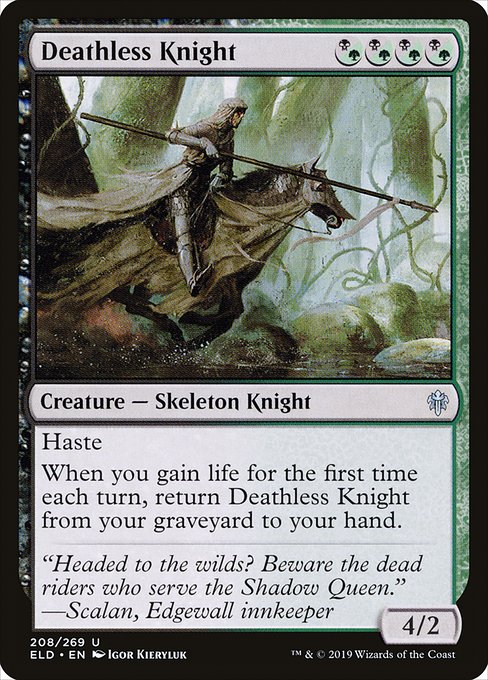
Image courtesy of Scryfall.com
Deathless Knight: Evolving illustration trends in modern MTG
In the sprawling mosaic of Magic: The Gathering, art isn’t just decoration—it’s a language. It speaks to the themes of a card, the music of its mechanics, and the era that produced it. Over the years, MTG illustration has shifted from bold, poster-like compositions to more nuanced, story-forward pieces that reward close looking and long rereads. The modern era has leaned into digital painting workflows, diverse palettes, and storytelling that blends fairy-tale whimsy with grim, haunting atmosphere 🧙♂️🔥. When you pair a card like Deathless Knight with that broader trend, you can practically see a conversation unfolding between the Digital Age’s precision and the tabletop’s tactile memory 🎨🎲.
A fairy-tale skeleton with a bite—the Eldraine painting ethos
Deathless Knight hails from Throne of Eldarine, a set that swirled fairy-tale vibes with classic MTG fantasy brutality. The set’s art direction leapt into story-first visuals: vibrant color choices, dramatic lighting, and characters that straddle heroism and menace. Igor Kieryluk’s illustration for this uncommon skeleton knight embodies that tension. The lanky silhouette, the gleam on the bone armor, and the sense that danger lurks just beyond the frame—these are deliberate choices that resonate with modern players who crave atmosphere as much as efficiency on the battlefield 🔥. The piece feels simultaneously mythic and macabre, a reminder that spooks and charm can ride the same creature into battle ⚔️.
The card’s hybrid mana cost—{B/G}{B/G}{B/G}{B/G}—is more than a function of gameplay. It signals a deliberate design choice to merge black’s theme of mortality with green’s vitality, dark murk with forest-green vitality. In art, that same fusion manifests as a palette that teeters between shadow and life, a visual shorthand for the card’s lifegain-triggered recursion. This is modern MTG art doing what it does best: packing layered meaning into a single look. The knight’s haste-ready stance plus a ritualistic flavor text about dead riders and the Shadow Queen adds a sense of narrative urgency that mirrors the card’s tempo on the table 🧙♂️🎲.
Mechanics as mood: how lifegain and recursion shape the art’s use
Deathless Knight’s real trick isn’t just the four-hybrid mana cost or the 4/2 body; it’s the layered interaction: haste, plus a graveyard-recovery loop tied to lifegain. When you gain life for the first time each turn, this knight hops back from the graveyard to your hand. That mechanic is a perfect foil for the evolving art trend—cards are designed to reward narrative thoughts, not just raw numbers. A viewer can imagine the knight charging back from shadowed roots, a motion aligned with Eldraine’s storytelling energy. In gameplay terms, the design invites players to build around lifegain triggers—cards that salivate when life totals rise—while the art rewards a player’s storytelling instincts, imagining each life gain as a spark that tears the living from the dead and brings the knight back into play 💎⚔️.
Collectors, foils, and the modern market story
As a black-bordered, uncommon creature, Deathless Knight sits at an accessible price point for casual collectors and newer players—foil versions running a touch higher than nonfoil, with rarity values that encourage a few thoughtful upgrades rather than a full-blown chase. The art’s popularity isn’t just about the mechanics; it’s about the mood the painting conjures. Modern MTG illustration often gains life in foil treatments and frame polish, turning a single card into a keepsake that captures a moment in the ongoing visual conversation of the game. The Knight’s story—flavor text and a haunting illustration—lends itself to display in sleeves and binders as a reminder that mortality and resilience can share a frame—and that the magic of Eldraine still has a few Gothic bows tucked into its fairy-tale sleeve 🧙♂️💎.
Blending nostalgia with present-day craft
For longtime players, the shift toward story-driven art is a welcome invitation back to the table—where a card’s illustration is as much a prompt for memory as it is a plan for the next turn. The Deathless Knight embodies this bridge: a familiar skeleton knight motif reimagined with Eldraine’s curiously warm lighting and dramatic poses, reminding veterans of the old-school skeleton tropes while inviting new players to savor the modern palette and compositional risk-taking. If you’ve ever found yourself pausing to study a card’s art before reading its text, you know this is one of MTG’s finest tricks: art that either confirms what you think you know or quietly nudges you toward a new appreciation of the game’s design vocabulary 🎨.
And there’s something satisfying about the tangible cross-promotion that keeps fans engaged across formats. If you’re into collectible gear, consider pairing the experience with a Slim Lexan phone case for iPhone 16—glossy, ultra-thin protection that travels as lightly as Eldraine’s characters travel between realms. It’s a small nod to the modern collector’s lifestyle, where aesthetics and function exist in a single, portable package.
Slim Lexan Phone Case for iPhone 16 – Glossy Ultra-ThinMore from our network
- https://crypto-acolytes.xyz/blog/post/top-meme-coins-for-survival-gamers-this-year/
- https://transparent-paper.shop/blog/post/designing-fonts-for-digital-marketplaces-best-practices/
- https://transparent-paper.shop/blog/post/radial-velocity-uncovers-galactic-flow-through-a-blue-hot-star/
- https://transparent-paper.shop/blog/post/monetizing-texture-packs-a-practical-online-selling-guide/
- https://blog.digital-vault.xyz/blog/post/automating-workflows-with-zapier-and-make-a-practical-guide/